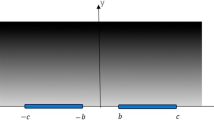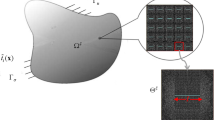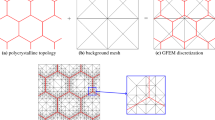Abstract
The brittle fracture behavior of periodic 2D cellular material weakened by a system of non-interacting cracks is investigated. The material is represented as a lattice consisting of rigidly connected Euler beams which can fail when the skin stress approaches some limiting value. The conventional Mode I and Mode II fracture toughness is calculated first and its dependence upon the relative density is examined. To this end the problem of a sufficiently long finite length crack in an infinite lattice produced by several broken beams is considered. It is solved analytically by means of the discrete Fourier transform reducing the initial problem for unbounded domain to the analysis of a finite repetitive module in the transform space. Four different layouts are considered: kagome, triangular, square and hexagon honeycombs. The results are obtained for different crack types dictated by the microstructure symmetry of the specific material. The obtained results allowed to define the directional fracture toughness characterizing the strength of a material with many cracks for the given tensile loading direction. This quantity is presented in the form of polar diagrams. For all considered layouts the diagrams are found to be close to circles thus emphasizing quasi-isotropic fracture behavior. The deviation from isotropy in the case of a square honeycomb is essentially less than for the corresponding published axial stiffness polar diagram.
Similar content being viewed by others
References
Ashby MF (1983) The mechanical properties of cellular solids. Metall Trans A 14: 1755–1769
Chen JY, Huang Y, Ortiz M (1998) Fracture analysis of cellular materials: a strain gradient model. J Mech Phys Solids 46: 789–828
Choi S, Sankar BV (2005) A micromechanical method to predict the fracture toughness of cellular materials. Int J Solids Struct 42(5–6): 1797–1817
Fleck NA, Qiu X (2007) The damage tolerance of elastic-brittle, two dimensional isotropic lattices. J Mech Phys Solids 55: 562–588
Fuchs MB (1992) The explicit expression of internal forces in prismatic membered structures. Mech Struct Mach 20: 169–194
Gibson LJ, Ashby MF (1997) Cellular solids. Structure and properties. Cambridge University Press
Huang JS, Gibson LJ (1991) Fracture toughness of brittle honeycombs. Acta Metall Mater 39: 1617–1626
Huang JS, Lin JY (1996) Mixed-mode fracture of brittle cellular materials. J Mater Sci 31: 2647–2652
Hutchinson JW, Mear ME, Rice JR (1987) Crack paralleling an interface between dissimilar materials. J Appl Mech 54: 828–832
Lipperman F, Ryvkin M, Fuchs MB (2007) Nucleation of cracks in two-dimensional periodic cellular materials. Comput Mech 39(2): 127–139
Maiti SK, Ashby MF, Gibson LJ (1984) Fracture toughness of brittle cellular solids. Scr Metall 18: 213–217
Nuller B, Ryvkin M (1980) On boundary value problems for elastic domains of a periodic structure deformed by arbitrary loads. Proc State Hydraulic Inst 136:49–55, Energia, Leningrad (in Russian)
Quintana Alonso I, Fleck NA (2007) Damage tolerance of an elastic-brittle diamond-celled honeycomb. Scr Mater 56: 693–696
Renton J (1966) On the analysis of triangular mesh grillages. Int J Solids Struct 2: 307–318
Ryvkin M, Nuller B (1997) Solution of quasi-periodic fracture problems by representative cell method. Comput Mech 20: 145–149
Schmidt I, Fleck NA (2001) Ductile fracture of two dimensional cellular structures. Int J Fract 111: 327–342
Sih GC, Paris PC, Irwin GR (1965) On cracks in rectilinearly anisotropic bodies. Int J Fract Mech 1: 189–203
Slepyan LI (1990) Mechanics of cracks. Sudostroenie, Leningrad (in Russian)
Slepyan LI, Ayzenberg-Stepanenko MV (2002) Some surprising phenomena in weak-bond fracture of a triangular lattice. J Mech Phys Solids 50: 1591–1625
Slepyan LI, Ayzenberg-Stepanenko MV (2004) Localized transition waves in bistable-bond lattices. J Mech Phys Solids 52: 1447–1479
Author information
Authors and Affiliations
Corresponding author
Rights and permissions
About this article
Cite this article
Lipperman, F., Ryvkin, M. & Fuchs, M.B. Fracture toughness of two-dimensional cellular material with periodic microstructure. Int J Fract 146, 279–290 (2007). https://doi.org/10.1007/s10704-007-9171-5
Received:
Accepted:
Published:
Issue Date:
DOI: https://doi.org/10.1007/s10704-007-9171-5




